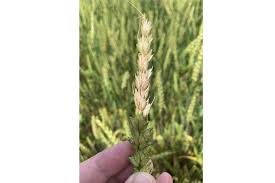Fusarium graminearum : Dangerous crop-killing fungus

The recent arrest of a Chinese researcher and charges against another for smuggling a dangerous crop-killing fungus Fusarium graminearum into the United States have brought renewed attention to the threat of agro-terrorism.
- It is a fungus that affects the kernel development of various grains, thereby reducing the yield.
- It can also cause ear rot or stalk rot in maize crops. Once infected, the fungus continues to spread as the crop matures.
- It is known to survive in plant tissue residues like small grain stems and roots and infect new plants.
- It causes Fusarium head blight—a disease that ravages cereal crops such as wheat, barley, maize, and rice.
- The fungus not only decimates yields but also produces a toxin called vomitoxin (deoxynivalenol), making the grain unsafe for human and animal consumption.
- According to the US Department of Agriculture, this disease causes over $1 billion in crop losses annually in the United States alone.
- Vomitoxin can cause vomiting, diarrhea, abdominal pain, and fever in livestock and people, further amplifying its public health impact.




